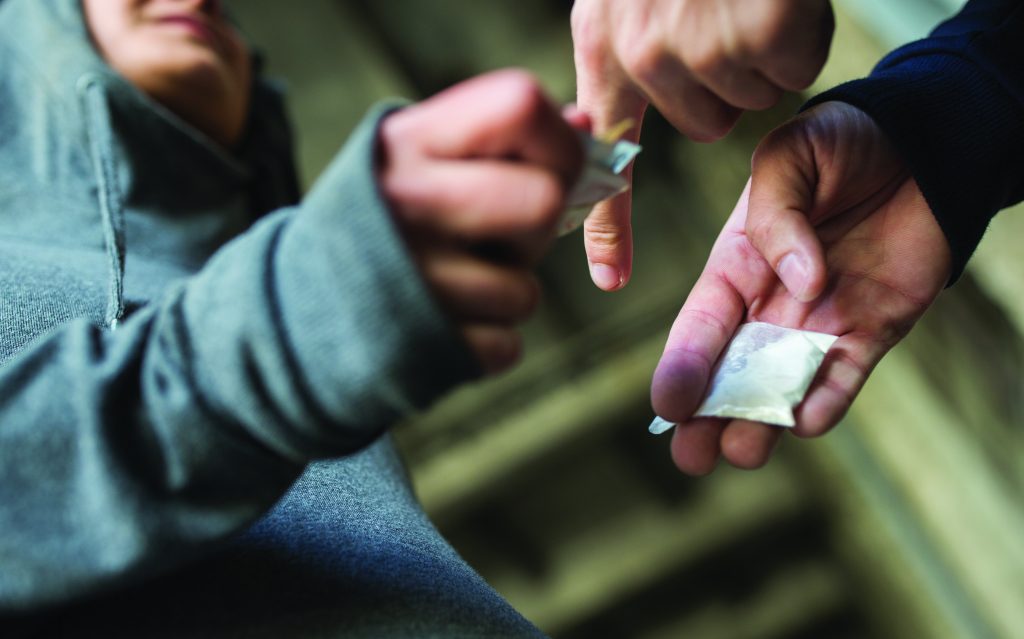
Features
Opinion
Mitigating risks during illicit narcotic sales protects police and civilians
September 22, 2023 By Michael W. Brown
 Photo credit: Syda Productions / Adobe Stock
Photo credit: Syda Productions / Adobe Stock The struggle with illicit narcotics continues unabated with the distribution and abuse of newer and more deadly synthetic opioids, such as fentanyl, quickly reaching crisis levels throughout Canada. While law enforcement has the ability to safely identify drugs seized in bulk, uniformed and narcotic task force members could be at risk when exposed to smaller quantities of unknown substances in their day-to-day tasks.
Far from the romantic idea of the officer identifying cocaine by dipping the tip of their finger into the packet of drugs and tasting it, doing so with fentanyl or narcotics laced with fentanyl, could cause harm to the officer. With so many variables and new strands of synthetics making their way onto the street, officers typically enter every call not knowing precisely what chemical they are handling. Officers need the means to quickly identify the unknown substance they are dealing with while on the scene, as well as develop new safety protocols to ensure they are not accidentally affected by the narcotics seized.
While illicit narcotics are potentially dangerous, fentanyl and narcotics laced with it are the most dangerous illicit opioids the world has yet encountered, and they are easy to manufacture. Fentanyl is odorless and tasteless, which means it is hard to detect when mixed with a supposed “less dangerous’ drug” like heroin. Only two milligrams of pure fentanyl (the size of about four grains of salt) is enough to kill the average adult.1 In Canada, 81 per cent of the opioid toxicity deaths in 2022 (about 20 deaths per day) involved fentanyl.2
While there is no textbook approach to illicit narcotics management, in some Canadian provinces (such as British Columbia3), small quantities of dangerous drugs are now permissible for personal use. However, as good as the intentions of these exercises are, the fact is that legalizing a potential poison does not make it safe and won’t suddenly turn substance users into responsible adults. These legalization policies have been tried in various countries, with the results described as “modest at best”.4
The problem is not simply going to vanish because the roots of substance addiction have been around for a long time and it is highly lucrative.5 These facts should drive Canadian law enforcement agencies to implement new safety protocols for officers, allowing them to quickly identify narcotics as well as protect themselves from contamination. There are three primary areas where officers need reliable safety protocols, allowing them to focus on their jobs and their responsibilities to the civilian population.
-
Street-level sales
Approaching dealers or substance users on the streets is fraught with danger for law enforcement. The suspects may react unpredictably by fighting or throwing narcotics at the officers and the substance may land on the officers’ hands during the process. While opioids are generally not absorbed directly through the skin (there are exceptions), if an officer has a cut or scratch on their hand, there is still a possibility that the narcotic could enter their blood stream. Moreover, if the narcotics are thrown into the eyes, or get into the nasal cavity, this presents the risk of being absorbed into the bloodstream.
Each officer’s situational awareness and knowledge of the potential risks helps them to protect themselves, but things ‘on the street’ don’t always go according to plan and the unthinkable sometimes becomes reality very quickly. Being able to identify the substance rapidly and accurately through presumptive analysis will allow for better risk mitigation or faster and more effective control processes if something happens.
Additionally, if the suspects are intravenous users, ‘needle-stick’ infections are also a risk. A simple prick from an infected needle may cause serious harm, not only in terms of the opioid, but harming the health of the officer in terms of contracting HIV or hepatitis infections. The risk of being infected by HIV from a needle-stick is low; only about 1 in 300 (less than 1 per cent) of healthcare workers who were accidentally pricked by a needle from someone with HIV were themselves infected. However, the risk of contracting a form of hepatitis is much higher (one in three if the person has not been vaccinated against Hepatitis).6
Unlike the healthcare sector, there is no scientific study yet that shows how likely an officer would be to be harmed by fentanyl accidentally absorbed or ingested in a struggle, or from a needle-stick, but the risk is there, and law enforcement leaders must work to implement safety protocols to mitigate the risk before injury occurs.
-
Controlled undercover purchases
Controlled undercover purchases are implemented by law enforcement officers using prerecorded funds to purchase narcotics, while obtaining the necessary evidence required to effect an arrest against a suspect or suspects.
Often an undercover drug buy does not lead to an immediate arrest but is part of a larger plan to catch bigger fish. In this instance, quickly identifying that the substance purchased was in fact fentanyl, heroin or another illegal substance, will allow the investigation to go ahead and streamline the path to obtaining the relevant warrants – since the judge can be assured the narcotic in question is real and not a sham.
The same applies to precursor chemicals used in the manufacture of fentanyl. Since making this illicit synthetic opioid is simple, being able to identify precursor drugs and the tools of the trade, which can easily be shipped via an everyday delivery service, is critical to successful apprehension and prosecution.
There are three primary areas where officers need reliable safety protocols, allowing them to focus on their jobs and their responsibilities to the civilian population.
The general view of drug crimes is that Mexican cartels smuggle drugs into Canada through the U.S.A., or that they come from China, but many precursors and tools used in manufacturing are being shipped into the country to create local labs to produce fentanyl and associated drugs in large quantities. Customs officials in other countries would be more careful to examine imports from Mexico, for example, than they would from destinations perceived as safe, such as Canada. This is naturally a circumstance the cartels would like to exploit.
-
Undercover monitoring narcotics purchases
This is the most complex of investigations and relies on the effective collection of intelligence, sometimes meaning months of work monitoring ‘hotspots,’ or safe areas, where drug sales and usage is allowed. While there are those who promote the benefits of these safe areas, including making sure the drugs used are safe and medical help or counseling is at hand if required, the sources of the narcotics are the same cartels and gangs law enforcement has been fighting for years.
Gathering intelligence on sales and relationships can assist in larger investigations and lead to operations that result in bulk seizures and arrests in various countries. Once again, the ability to quickly identify what narcotics are being sold and by whom will assist in ensuring law enforcement does not go on a wild goose chase after sham drugs but can focus on the real and most dangerous drugs and their sources.
Of course, the instruments chosen to run this analysis must be reliable and provide accurate results every time if they are to deliver value. A bad result can destroy a whole case, raise questions in court of the validity of all the evidence collected as well as the warrants issues. A colossal waste of time and resources.
Risk mitigation strategies
Risk mitigation protocols are nothing new to law enforcement. Body armor, for example, became a standard part of the uniform to protect officers from gun violence. However, while body armor offers a high degree of protection, there is no 100 per cent guarantee of safety. Specially designed gloves and boots were recommended to prevent knife attacks leading to deadly force responses (as well as protection against needle-sticks). Similarly, when law enforcement wanted to reduce the number of cases of deadly force used by the police, tasers were issued to give officers an effective, yet non-lethal option.
The protocols that can and should be introduced to prevent opioid injury include simple issues such as washing one’s hands before and after any interaction with narcotics, or checking for cuts and scratches on hands and forearms and dealing with them before starting a shift. Protective eye wear and gloves are also a simple option to prevent accidental infection and when entering drug manufacturing labs and facilities, masking up (to use a COVID term), should also be adopted.
In addition, law enforcement officers tasked with dealing with narcotics on a daily basis should be using Raman spectroscopy. Raman spectroscopy7 has been recognized as one of the Class A analytical techniques for presumptive field testing by the Scientific Working Group for the Analysis of Seized Drugs (SWGDRUG). This global organization is responsible for supporting the development of recommended standards, techniques, protocols and policies for the forensic examination of seized drugs.
Any mitigation protocols developed to protect against potential narcotic effects or health consequences will not be 100 per cent effective, especially in a society without respect for law enforcement officers. Violence and aggression are part of the daily routine for officers today. However, when protocols are developed and enforced, risk is reduced. This leaves the officers with fewer threats to focus on, enabling them to concentrate on the job at hand, their own wellbeing as well as the welfare of those they encounter. This ensures everyone’s safety and allows the law to take its course without prejudice.
References
- “Effects and Risks of Fentanyl.” Drug Free Kids Canada. Accessed at https://www.drugfreekidscanada.org/drug-spotlights/fentanyl/effects-and-risks-of-fentanyl/.
- “Opioid- and Stimulant-related Harms in Canada (June 2023).” Government of Canada. Accessed at https://health-infobase.canada.ca/substance-related-harms/opioids-stimulants/.
- McCulloch, Craig. “Canadian Province Decriminalizes Small Amount of Hard Drugs.” VOA News. February 2023. Accessed at https://www.voanews.com/a/canadian-province-decriminalizes-small-amount-of-hard-drugs/6944480.html#.
- Eisele, Ines. “Canadian province decriminalizes hard drugs.” Deutsche Welle. February 2023. Accessed at https://www.dw.com/en/canadian-province-decriminalizes-hard-drugs/a-64605313.
- “Seized precursors could have made 262 million potentially lethal doses of fentanyl.” Royal Canadian Mounted Police. March 2023. Accessed at https://bc-cb.rcmp-grc.gc.ca/ViewPage.action?contentId=78849&languageId=1&siteNodeId=2087.
- Reiff Ellis, Rachel. “Needle Stick Injury: What to Do.” WebMD. May 2023. Accessed at https://www.webmd.com/hiv-aids/needle-stick-injury-what-do.
- “Scientific Working Group for the Analysis of Seized Drugs Recommendations.” United States Department of Justice – Drug Enforcement Administration. August 2022. Accessed at https://swgdrug.org/Documents/SWGDRUG%20Recommendations%20Version%208.1_FINAL_ForPosting_Rev%201-23-23.pdf.
 Michael W. Brown has a distinguished career spanning more than 32 years as a special agent for the Drug Enforcement Administration (DEA). Contact him at michael.brown@rigaku.com.
Michael W. Brown has a distinguished career spanning more than 32 years as a special agent for the Drug Enforcement Administration (DEA). Contact him at michael.brown@rigaku.com.
Print this page